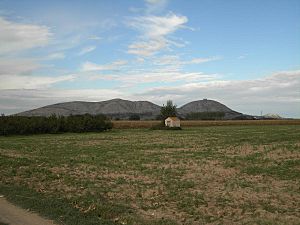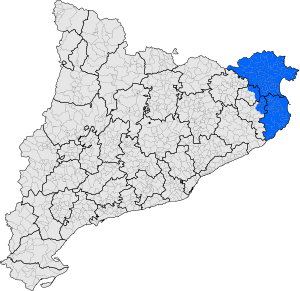Empordà facts for kids
Quick facts for kids
Empordà
|
|
|---|---|

Landscape of the Montgrí Massif in the Empordà region.
|
|

A map of Catalonia showing the Empordà location
|
|
| Country | Catalonia, Spain |
| Elevation | 40 m (130 ft) |
Empordà is a beautiful natural and historical region in Catalonia, Spain. It's known for its stunning landscapes and rich history. Since 1936, Empordà has been split into two parts: Alt Empordà and Baix Empordà.
The city of Figueres is a major center for Alt Empordà. It's a busy place for business and city life. For Baix Empordà, the capital is La Bisbal d'Empordà. This choice was made based on its history and location.
Empordà is also famous as a birthplace for many art styles. One of the most well-known is surrealism. Famous artists like Salvador Dalí, Angel Planells, Joan Massanet, and Evarist Vallès came from this inspiring region.
Contents
What Does Empordà Mean?
The name Empordà comes from the ancient city of Empúries. In Old Greek, Empúries was called Empòrion, and in Latin, Emporiae. Both names mean "the markets." This tells us that the area was once a busy trading place!
The name Empordà also comes from the County of Empúries. This was an important county in the past. Its first capital was Sant Martí d'Empúries. Later, the capital moved to Castelló d'Empúries. This town became the main city of medieval Empordà. The county was quite independent and joined the Crown of Aragon later than others. This led to some interesting events, like changing the path of the Ter (river) and trying to build the Montgrí Castle.
A writer from Baix Empordà, Josep Pla, used to call the area around his hometown of Palafrugell "Empordanet." This means "little Empordà." He used this name for the land between the Gavarres mountains and the Montgrí Massif. People still use this sweet name today for Baix Empordà.
A Look at Empordà's Past
Empordà has been home to people for a very long time, even before history was written down!
Ancient Times
- Stone Age Homes: In the Montgrí Massif, there are caves where people lived during the Stone Age. The most famous ones are called "Cau Del Duc." You can find one in Torroella and another in Ullà.
- Giant Stone Structures: You can also see large stone structures called dolmens in places like Massís de les Gavarres and Massís de Cadiretes. The dolmens in Fitor are very important examples.
Greek and Iberian Settlements
- Greek Traders: The ancient Greeks arrived close to Empordà around the 8th century BC. They settled in Roses. They also built a city in Empúries in the early 6th century BC.
- Iberian City: The Iberians, a local tribe called the Indigetes, built one of their main cities in Ullastret around the 6th century BC.
- Roman Arrival: When the Romans came, things changed a lot. They brought new ways of living and farming. This led to the people leaving Ullastret by the 2nd century BC.
Roman and Medieval Eras
- Roman Influence: Like many places, Baix Empordà became part of the Roman Empire. You can still find many signs of Roman life there.
- Later Invasions: After the Romans, there were invasions by other groups in the 3rd and 5th centuries. This made the region poorer and its towns much smaller.
- Visigoths and Arabs: It's harder to see the mark of the Visigoths and the Arabs. The Muslim rule was quite short, lasting less than 60 years (from 714 to 785 AD). After this, the old Spanish-Gothic people returned.
- Counties and Shipyards: The Carolingian Empire divided the land into counties. The northern part, now Alt Empordà, was organized around the County of Empúries. Other areas were linked to the Bishop of Girona or noble families. Empordà became an important port area. The first shipyards in Empordà were built as early as the 10th century!
See also
 In Spanish: Ampurdán para niños
In Spanish: Ampurdán para niños

